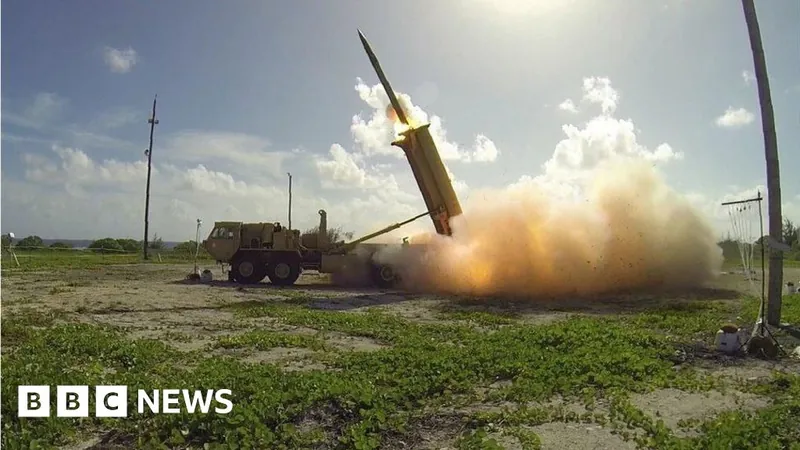
Why is the US Deploying the Powerful Thaad Anti-Missile System to Israel?
2024-10-14
Author: Charlotte
The Pentagon has officially announced the deployment of a high-altitude anti-missile system, the Terminal High-Altitude Area Defense (Thaad), to Israel, marking a significant military assistance move aimed at enhancing the country’s air defenses amid escalating regional tensions. The decision comes on the heels of a recent missile attack from Iran that involved over 180 ballistic missiles targeting Israel, resulting in heightened concerns for national security.
President Joe Biden emphasized that this deployment is focused on bolstering the defense of Israel, a country poised to retaliate decisively against Iran's aggression. Israeli Defense Minister Yoav Gallant has assured the public that the forthcoming reprisal will be “lethal, precise, and above all, surprising.” This reflects the ongoing conflict dynamics, especially surrounding the assassination of Hassan Nasrallah, a key figure in Iranian-backed Hezbollah, which Iran has cited as the motive behind its missile strikes.
The Thaad system, operated by a contingent of around 100 U.S. troops, has become a focal point of international scrutiny. For the U.S., such a deployment signifies a deeper entrenchment in the Middle Eastern conflict as tensions continue to escalate. Experts are now analyzing whether the Thaad's presence indicates inadequacies in Israel's existing missile defense systems or suggests American fears of a more aggressive Israeli response towards Iran.
With Biden firmly opposing any strikes against Iranian nuclear facilities or energy infrastructure, the explosive situation emphasizes the delicate balance of power and diplomacy in the region. The Thaad system is considered one of the most advanced missile defense technologies, particularly against high-speed ballistic threats, marking a significant investment in Israel’s military capabilities. Each Thaad battery, which costs approximately $1 billion, consists of six truck-mounted launchers capable of launching eight interceptors each.
Importantly, the missile threat isn’t limited to Israel. Other nations, such as Ukraine and Saudi Arabia, are also seeking to acquire such advanced systems as a countermeasure against regional threats. The recent Iranian missile strikes served to illustrate the urgency of such defenses; satellite imagery revealed extensive damage at key military sites in Israel, including the Nevatim airbase, which is crucial for operations involving F-35 stealth fighters.
While the U.S. and Israel highlight the effectiveness of existing defense systems like Arrow 2 and Arrow 3—designed to intercept missiles in space—the Israeli air force suffered visible damage that challenge claims of total efficacy. This interplay of attacks, countermeasures, and military strategies underlines the intricate web of violence and defense in the region.
In the wake of these missile strikes, the Biden administration insists that the United States remains committed to Israel’s military support, having already sent over 50,000 tons of weaponry in the past year alone. However, this love for military assistance comes with policy challenges, as Washington attempts to navigate the complex landscape of regional politics, balancing between supporting Israel and advocating for de-escalation in conflicts.
Iranian officials, including Foreign Minister Abbas Araqchi, condemned the U.S. troop presence in Israel. They argue that this deployment puts American lives at risk due to the ongoing tensions spurred by U.S. support for Israel.
As the situation continues to evolve, the implications of America’s military positioning and the responses from Iran and its allies will shape the future of regional security and the longstanding Israeli-Palestinian conflict. Observers are left questioning the effectiveness of current strategies and the path forward in an increasingly volatile Middle East.









 Brasil (PT)
Brasil (PT)
 Canada (EN)
Canada (EN)
 Chile (ES)
Chile (ES)
 España (ES)
España (ES)
 France (FR)
France (FR)
 Hong Kong (EN)
Hong Kong (EN)
 Italia (IT)
Italia (IT)
 日本 (JA)
日本 (JA)
 Magyarország (HU)
Magyarország (HU)
 Norge (NO)
Norge (NO)
 Polska (PL)
Polska (PL)
 Schweiz (DE)
Schweiz (DE)
 Singapore (EN)
Singapore (EN)
 Sverige (SV)
Sverige (SV)
 Suomi (FI)
Suomi (FI)
 Türkiye (TR)
Türkiye (TR)